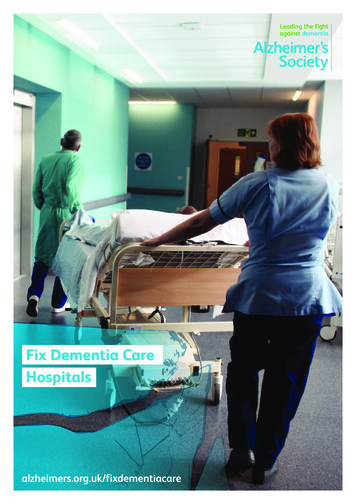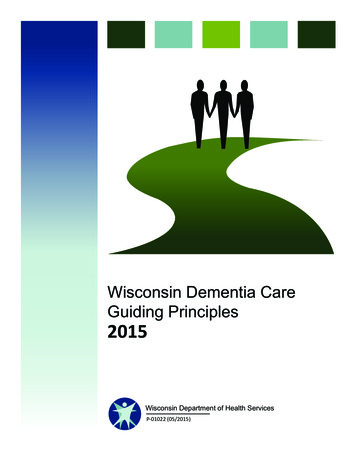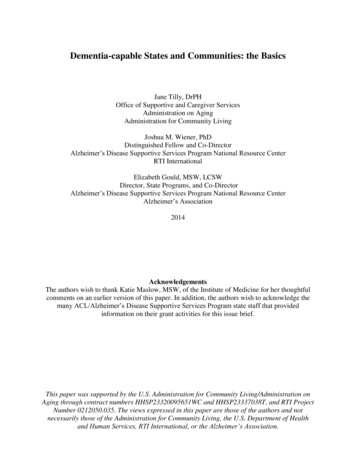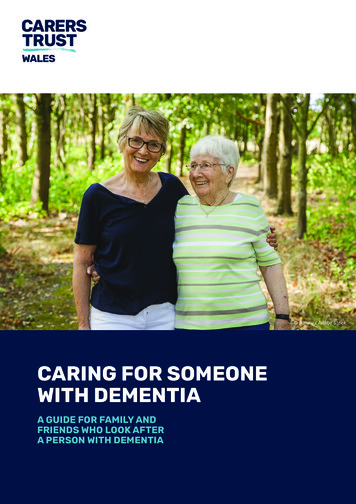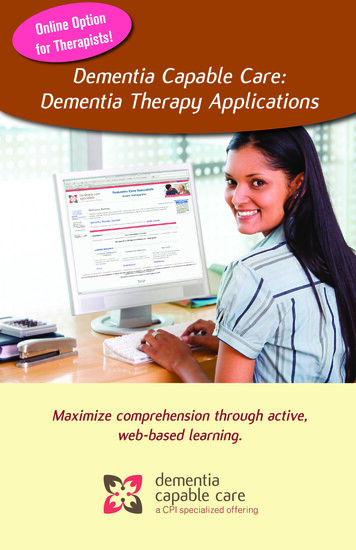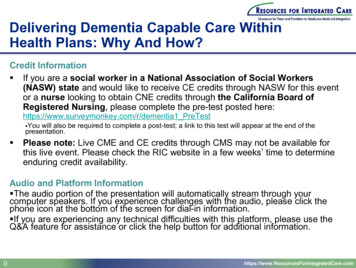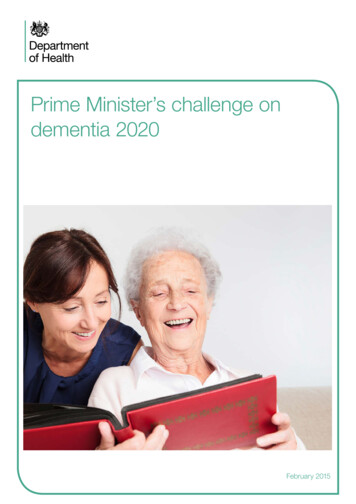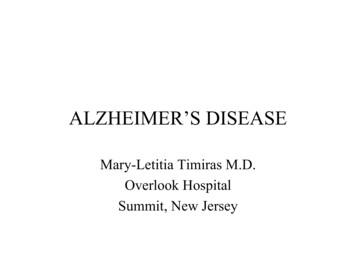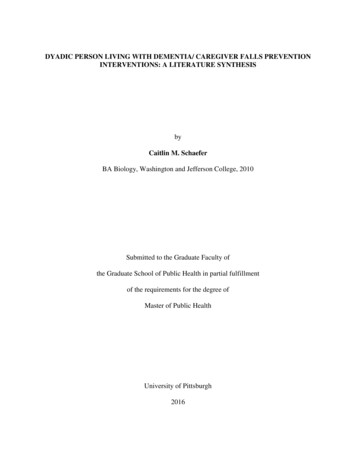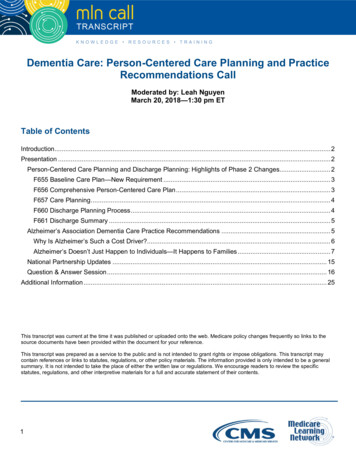
Transcription
Dementia Care: Person-Centered Care Planning and PracticeRecommendations CallModerated by: Leah NguyenMarch 20, 2018—1:30 pm ETTable of ContentsIntroduction. 2Presentation . 2Person-Centered Care Planning and Discharge Planning: Highlights of Phase 2 Changes. 2F655 Baseline Care Plan—New Requirement . 3F656 Comprehensive Person-Centered Care Plan . 3F657 Care Planning . 4F660 Discharge Planning Process . 4F661 Discharge Summary . 5Alzheimer’s Association Dementia Care Practice Recommendations . 5Why Is Alzheimer’s Such a Cost Driver?. 6Alzheimer’s Doesn’t Just Happen to Individuals—It Happens to Families . 7National Partnership Updates . 15Question & Answer Session . 16Additional Information . 25This transcript was current at the time it was published or uploaded onto the web. Medicare policy changes frequently so links to thesource documents have been provided within the document for your reference.This transcript was prepared as a service to the public and is not intended to grant rights or impose obligations. This transcript maycontain references or links to statutes, regulations, or other policy materials. The information provided is only intended to be a generalsummary. It is not intended to take the place of either the written law or regulations. We encourage readers to review the specificstatutes, regulations, and other interpretive materials for a full and accurate statement of their contents.1
Operator: At this time, I would like to welcome everyone to today’s Medicare Learning Network Event. Alllines will remain in a listen-only mode until the question-and-answer session.This call is being recorded and transcribed. If anyone has any objections, you may disconnect at this time. I willnow turn the call over to Leah Nguyen. Thank you. You may begin.IntroductionLeah Nguyen: I am Leah Nguyen from the Provider Communications Group here at CMS and I am yourmoderator today. I would like to welcome you to this Medicare Learning Network Call on Dementia Care:Person-Centered Care Planning and Practice Recommendations.During this call, gain insight into the Phase 2 changes for person-centered care planning and dischargeplanning. Also, learn about the new Alzheimer’s Association dementia care practice recommendations.Additionally, CMS shares updates on the progress of the National Partnership To Improve Dementia Carein Nursing Homes. A question-and-answer session follows the presentations.Before we get started, you received a link to the presentation in your confirmation email. The presentation isavailable at the following URL: go.cms.gov/npc. Again, that URL is go.cms.gov/npc.At this time, I would like to turn the call over to Michele Laughman, a Health Insurance Specialist within theDivision of Nursing Homes at CMS.PresentationMichele Laughman: Thank you, Leah. As Leah mentioned, our first presentation will be on person-centeredcare planning and discharge planning.Our speaker for this presentation will be Debra Lyons, a Health Insurance Specialist within the Division ofNursing Homes here at CMS. Deb, I now turn it over to you.Person-Centered Care Planning and Discharge Planning: Highlights of Phase 2 ChangesDebra Lyons: Thanks, Michele. Hi, everyone. My name is Debra Lyons. As Michele said, I work in the Divisionof Nursing Homes here at the Centers for Medicare & Medicaid Services.Today I want to share with you highlights of recent changes to the person-centered care planning anddischarge planning requirements for nursing homes.If you go to slide 5, as most of you know, the final rule of the reform of the requirements for long-term carefacilities went into effect on November 28, 2016, with Phase 2 of the final rule being implemented onNovember 28, 2017.2
Among the overall changes that went into effect this past November was the renumbering of the F-tags andinterpretive guidance to surveyors related to each of the F-tags was revised, which included person-centeredcare planning and discharge planning. Today I will highlight some of those changes.But first, let’s talk about what person-centered care is. If you to go to slide 6, person-centered care means tofocus on the resident as the locus of control and supports each resident’s choice and gives them a sense ofcontrol over their daily lives.According to the authors of the final rule, person-centered care was a central theme that was woventhroughout the final long-term care rule. The authors of the final rule said that the focus of person-centeredcare was intended to improve residents’ quality of life and quality of care.F655 Baseline Care Plan—New RequirementPerson-centered care is supported both directly and indirectly by many of the regulatory sections in therequirements for participation. Now we’ll walk – now we’ll talk about the changes to care planning anddischarge planning if you go to slide 7.F655 is a new requirement for a baseline care plan. The regulations state the baseline care plan must bedeveloped within 48 hours of the resident’s admission and must contain the minimum health care informationnecessary to care for the resident. Additionally, a written summary of the baseline care plan must be providedto the resident or their representative, if applicable.Guidance to surveyors clarifies that the written summary must be provided to the resident and/or his or herrepresentative by completion of the comprehensive care plan and include any changes in the resident’s goalsor interventions and submissions.Slide 8. And this new requirement is intended to promote the continuity of care and communicationamong staff, increase resident safety, safeguard against adverse events, and ensure the resident and/orrepresentative are informed of the initial plan of care.F656 Comprehensive Person-Centered Care PlanSlide 9. At F656, or comprehensive person-centered care plan, which was formerly F279, here you’ll findrequirements for facilities to develop and implement a comprehensive person-centered care plan that includesmeasurable objectives and timeframes to meet a resident’s medical, nursing, mental, and psychosocial needsand describes individualized resident goals, preferences, and desired outcomes.The guidance at F656 has been greatly expanded to define measurable objectives and provides examples ofindividualizing care plan goals and preferences.Slide 10. In addition to addressing residents’ needs, goals, and preferences, the comprehensiveperson-centered care plan must address the resident’s desired outcomes, including a description ofpreferences related to discharge, which would include referrals to any local contact agency, a discharge plan ifapplicable, and any specialized services from PASARR recommendations.3
F657 Care PlanningSlide 11. F657 contains the requirements for care plan timing and/or revision as well as new requirements forthe composition of the interdisciplinary team, or the IDT. This was formerly F280.In addition to the attending physician and the registered nurse with responsibility for the resident, there is anew requirement for a nurse aide with responsibility for the resident and a member of food or nutrition servicesto be on the IDT.The resident continues to be a required member, but there is a new requirement for the representative to beincluded, if applicable. And, as previously required, other appropriate staff must be on the interdisciplinaryteam.But a new requirement that other professionals, as determined by the resident or their need, has been added.Guidance has been expanded to address participation of the interdisciplinary team members and, in particular,the attending physician.Slide 12. F657 continues with surveyor guidance acknowledging the importance of physician input into thedevelopment of the care plan and provides flexibility for participation.Guidance at F657 explains that if the attending physician is unable to participate in the development of thecare plan, he or she may delegate participation to a nonphysician practitioner who is involved in the resident’scare to the extent permitted by State law or arrange alternative methods of participation, such as one-on-onediscussions, videoconferencing, and conference calls with the IDT.F660 Discharge Planning ProcessSlide 13. F660 contains the requirements for discharge planning. This was formerly F284. The regulations andguidance have been significantly expanded in an effort to ensure facilities have an effective discharge planningprocess that is person centered. This means the discharge plan focuses on the resident’s goals and preparesthe resident to safely transition to post-discharge care by reducing factors which may lead to rehospitalizationsor readmissions.Slide 14. Guidance at F660 clarifies the discharge care plan is part of the comprehensive care plan andmust be developed by the interdisciplinary team and involve direct communication with the resident and,if applicable, the resident representative. It must address the resident’s goals for care and treatmentpreferences. And it must identify needs that must be addressed before the resident can be discharged, such asresident education, rehabilitation, and caregiver support and education.Slide 15. Continuing the guidance at F660, the discharge care plan must be reevaluated regularly and updatedwhen the resident’s needs or goals change. It must document the resident’s interest in and any referrals madeto the local contact agency. And it must identify post-discharge needs, such as nursing and therapy services,medical equipment or modifications to the home, or ADL assistance required.4
F661 Discharge SummarySlide 16. At F661, you see the requirements for the discharge summary. The requirements and guidancehave been expanded in an effort to ensure facilities communicate necessary information to the resident, theircontinuing care provider, and any other authorized persons at the time of discharge.At slide 17, we see the guidance that F661 explains, that a discharge summary must include an accurate andcurrent description of the clinical status of the resident, must provide individualized care instructions to ensurethe resident transitions safely from one setting to another. The discharge summary may help reduce oreliminate confusion among the various facilities, agencies, practitioners, and caregivers involved with theresident’s care.And here on slide 18, we have included some resources for providers, including a link to the surveyorguidance which I spoke of as well as to a website that contains many helpful resources for nursing homes.I want to thank each of you for your time, and I’m going to turn it over to Michele Laughman to introduce ournext speaker.Michele Laughman: Thank you, Deb. Our next presentation will focus on the new Alzheimer’s Associationdementia care practice recommendations. Our speaker for this presentation will be Douglas Pace, Directorof Mission Partnerships within the Alzheimer’s Association. Doug, I turn it to you.Alzheimer’s Association Dementia Care Practice RecommendationsDouglas Pace: Thanks, Michele, and good afternoon. I appreciate the opportunity to be with you. And onbehalf of the Alzheimer’s Association, I want to thank all of you for the work you do to advance qualitydementia care.So today I thought it would be helpful to remind us of the tremendous impact of this disease by looking at someof the latest facts and figures, talk about the risk factors, introduce you to our new dementia care practicerecommendations that were just released in the February special supplement of The Gerontologist , anddiscuss our next steps. And my hope is that the information that I share with you today will help you in yourwork in improving the quality of care and the quality of life for those with dementia.And on slide 31, and most of you know about the Alzheimer’s Association. We are the world’s leadingvoluntary health organization in Alzheimer’s care, support, and research. And we work on a global, national,and a local level through our home office and our 71 chapters nationwide to provide care and support for allthose affected by Alzheimer’s and other dementias.Our mission is to eliminate Alzheimer’s disease through the advancement of research, to provide care andsupport for all affected, and to reduce the risk of dementia through the promotion of brain health. And ourvision is a world without Alzheimer’s.So each year the Association publishes our Facts and Figures report. And I’m glad to announce that the2000 Facts and Figures report was just released today. And this is a great resource. You can download a copy5
of it at alz.org/facts. So Facts and Figures is one way to put a face on this disease and for all of us tounderstand why Alzheimer’s should be a national priority. And the rapid aging of America as baby boomersenter the greatest risk of Alzheimer’s means a dramatic rise in the number of cases in the coming years. Solet’s take a look at some of these statistics from the 2017 report.But before we do, on slide 23, I thought it would be helpful to remind us that dementia is an umbrella term usedto describe a wide range of symptoms associated with cognitive impairment. And while Alzheimer’s diseasecomprises the majority of dementias, there are other types, such as vascular, Lewy bodies, andfrontotemporal. So the number of Americans living with Alzheimer’s disease is growing.And it’s growing really fast. There’s an estimated five and a half million Americans living with Alzheimer’sdementia today. About 5.3 million of those are age 65 and older, and 200,000 are under age 65 withyounger-onset Alzheimer’s. So by 2050, this number could reach as high as 16 million. And among those65 and older, 1 in 10 has Alzheimer’s. And among those 85 and older, 1 in 3 has Alzheimer’s.So on slide 25, you can see that Alzheimer’s disease is currently the most expensive disease in America, withcosts soaring past a quarter of a trillion dollars for the first time for paid care.And as you know, most of these costs are borne by Medicare and Medicaid. And in 2017, Medicare andMedicaid spent an estimated 175 billion caring for those with Alzheimer’s and other dementia, and thatrepresents about 68 percent of the total cost.And on slide 26, we know that Alzheimer’s disease is a major driver of these health care costs. So Medicarepayments for a senior with Alzheimer’s or another dementia are more than three times as great for a seniorwithout these conditions. And Medicaid payments are 23 times as great.Slide 27 gives us a way to look at cost for Medicare beneficiaries with or without Alzheimer’s and otherdementias. And as you can see, the per-person payments are about 33,000 a year higher per year forpeople with Alzheimer’s.Why Is Alzheimer’s Such a Cost Driver?So why is it such a cost driver? Nearly 30 percent of people with Alzheimer’s or other dementias are dualeligible—they’re on both Medicare and Medicaid—compared to 11 percent of people without dementia.Another reason that Alzheimer’s is such a cost driver is that people with Alzheimer’s are more likely thanpeople without dementia to have other chronic conditions. And the dementia complicates the management ofthose conditions. And we also know that medication adherence is a big issue for this population and can be acost driver.So slide 30 provides two good examples that a person with diabetes and Alzheimer’s costs Medicare81 percent more than a person with only diabetes. And a senior with Alzheimer’s and cancer costs Medicare57 percent more than a person with only cancer.6
And costs will continue to grow. The cost for caring with people and other Alzheimer’s and other dementiasare projected to increase from 259 billion in 2017 to 1.1 trillion in 2050 unless we have some groundbreakingmedical science research between now and then.Alzheimer’s Doesn’t Just Happen to Individuals—It Happens to FamiliesAnd on slide 32, we see, besides the cost of Medicare and Medicaid and other long-term services andsupports, Alzheimer’s disease affects families significantly. In 2016, more than 15 million family members andfriends provided more than 18 billion hours of unpaid care.And the economic value of that unpaid care totaled 230.1 billion in 2016. Now our 2016 Facts and Figuresreport, which is still available on our website, featured a special report on the personal impact of Alzheimer’son families.The – and you can see on slide 34, the 2016 report highlights that Alzheimer’s just doesn’t happen toindividuals; it happens to families. Caregivers had almost 11 billion in additional health care costs due to theirown tremendous physical and emotional burdens of caregiving.And nearly half of care contributors, those who are caregivers with someone with Alzheimer’s and/or contributefinancially to their care, cut back on their own expenses, including food, transportation, and medical care, topay for dementia-related care of a family member or a friend. And care contributors are 28 percent more likelythan other adults to eat less or go hungry just because they simply can’t pay for food. And 1 in 5 carecontributors cut back on their own doctor visits because of their care responsibilities. And amongst caregivers,74 percent report that they are somewhat to very concerned about maintaining their own health sincebecoming a caregiver. And on average, care contributors lose over 15,000 in annual income as a resultof reducing or quitting work to meet the other demands of caregiving.So slide 35 shows another way to look at the impact. If Alzheimer’s and dementia caregivers were theresidents of a State, it would be the fifth-highest populated State in the country. And if you combine that withthe 5.5 million people living with the disease, it would be the third-highest populated State in the country today.I mean, those are just truly staggering numbers.So slide 36 reminds us that Alzheimer’s is now the sixth leading cause of death in the U.S. and the fifth leadingcause of death for those age 65 and older. And it’s important to remember that this is a fatal disease and theonly disease in the top 10 that can’t be prevented, slowed, or stopped. And an estimated 700,000 Americansdied with Alzheimer’s disease in 2017.So you can see on slide 37, from 2000–2014, Alzheimer’s disease deaths have increased by 89 percent, whileyou can see from the slide that other deaths from other diseases have been declining. And part of the reasonfor the decrease in deaths from other conditions is due to increased funding in medical science research.In 2012, an expert panel of scientists concluded that annual Alzheimer’s and dementia research funding wasfar short of what was necessary to achieve breakthroughs and developing preventions and effectivetreatments. But the good news is, thanks to bipartisan efforts in Congress, funding to the National Institutesof Health, NIH, has been increasing. And NIH is expected to spend 1.4 billion on Alzheimer’s and dementia7
research in 2017. And encouragingly, for fiscal year 2018 funding levels, the House Appropriations Committeepassed a 400 million increase and the Senate Appropriations Committee a 414 million increase. And thefinal funding level for fiscal year ’18 is still pending before Congress. But we expect action on that actually byMarch the 23rd, so, very soon.So let’s spend on slide 38 a couple of minutes talking about risk factors. So here’s a picture of Germanphysician Alois Alzheimer in 1906, who was a pioneer in linking symptoms to microscopic brain changes. Andthe picture above is a 50-year-old patient who he describes had a peculiar disease with profound memory loss,unfounded suspicions about her family, and other worsening psychosocial changes. And in her brain atautopsy, he saw dramatic shrinkage and abnormal deposits in and around nerve cells.And since then, scientists have identified several hallmark brain abnormalities, including plaques, whichare those microscopic clumps of the protein fragment called beta-amyloid; and tangles, which are twisted,microscopic strands of the protein tau; and loss of connections among brain cells that are responsible formemory, learning, and communication. And these connections or synapses transfer information from cell tocell. And then we know there’s the eventual death of brain cells and severe tissue shrinkage. So whilescientists know that Alzheimer’s disease involves the progressive failure of brain cells, we still don’t knowwhy this happens.But we have identified certain risk factors that increase the likelihood of developing Alzheimer’s, and I’m nowon slide 39. And we know that age is the greatest known risk factor for Alzheimer’s.Another risk factor is family history. So research has shown us that those who have a parent, brother, or sisterwith Alzheimer’s are more likely to develop the disease.And the risk increases if more than one family member has the illness. But when diseases tend to run in family,either heredity—genetics—or environmental factors, or both, may play a role. Now scientists have identifiedone gene that increases the risk for Alzheimer’s, but it doesn’t guarantee an individual will develop the disease.Research has also revealed certain rare genes that virtually guarantee an individual will develop Alzheimer’s.But those genes have been found in only a few hundred extended families worldwide and account for less than5 percent of all Alzheimer – all cases of Alzheimer’s worldwide.Most experts also believe that the majority of Alzheimer’s disease is – occurs as a result of complexinteractions between genes and other risk factors. So age, family history, and heredity are all risk factorswe can’t change. But now research is beginning to reveal clues about other risk factors we may be able toinfluence through general lifestyle and wellness choices and effective management of other health conditions.There may be a strong link between serious head injury and the future risk of Alzheimer’s, especially whentrauma occurs repeatedly or involves the loss of consciousness.And growing evidence links brain health to heart health. So our brain is nourished by one of our body’s richestnetworks of blood vessels. Our heartbeat pumps about 20–25 percent of our blood to our head, where braincells use at least 20 percent of the food and oxygen that your blood carries. So the risk of developingAlzheimer’s or vascular dementia appears to be increased by many conditions that damage the heart or bloodvessels. And these include high blood pressure, heart disease, stroke, diabetes, and high cholesterol. Andother lines of evidence suggest that strategies for overall healthy aging may help keep your brain as well as8
your body fit. And these strategies might even offer some protection against developing Alzheimer’s or relateddisorders, like keeping your weight within recommended guidelines, avoiding tobacco and excess alcohol,staying socially connected, and exercising both your body and your mind.And now on slide 40. We know also that women are at the epicenter of this disease. Today, nearly two-thirdsof Americans living with Alzheimer’s are women, and over 60 percent of Alzheimer’s and dementia caregiversare women. For a woman in her 60s, the estimated lifetime risk of developing Alzheimer’s is 1 in 6 compared to1 in 11 for breast cancer.On slide 41, we also know that African-Americans are twice as likely as Whites to have Alzheimer’s or anotherdementia, and Hispanics are one and a half times as likely. And although the rate is higher, they are like – theyare less likely to have a diagnosis of the condition. And when they are diagnosed, African-Americans andHispanics are typically diagnosed in the latter stages of the disease when they are more cognitively andphysically impaired and therefore need more medical care.Now, genetic factors don’t appear to account for the greater prevalence of or the greater risk of developingAlzheimer’s. But high blood pressure and diabetes are suspected risk factors, and these are more prevalentin these communities. And these conditions, among others, may contribute to the greater prevalence inthese groups.But as you can see on slide 42, there’s some good news that early evidence shows us that modifiable riskfactors may make a difference. There’s a lot of unanswered questions and significant uncertainty with respectto the relationship between individual factors in dementia. But there are research studies underway that haveshown that regular physical activity and management of cardiovascular risk factors may reduce the risk ofcognitive decline and may reduce the risk of dementia. So also, lifelong learning and cognitive training and ahealthy diet may reduce the risk of cognitive decline. So we’ve developed 10 ways that we are promoting tohelp love your brain.But the main reason for our call today is to talk about the Association’s updated dementia care practicerecommendations. The Association has a commitment to quality care.In the early ’90s, we published “Guidelines for Dignity,” followed by “Key Elements of Dementia Care.” Andour most recent recommendations were published between 2005 and 2009, with distinct recommendationsfor nursing homes and assisted living, end-of-life care, and working in a home care setting.But as you can see on slide 45, our new recommendations are peer reviewed and evidence based, publishedin a special supplement of The Gerontologist in February. And there’s 56 recommendations by 27 nationallyrecognized experts that now provide a foundation for quality person-centered dementia care.And you could see on slide 46 that the new recommendations are intended for health care professionalsworking in long-term care and community-based settings and are applicable to all settings.The recommendations are anchored in person-centered care, and the additional topic areas are detection anddiagnosis; assessment and care planning; medical management; information, education, and support; ongoing9
care; workforce; supportive and therapeutic environment; and transition and coordination of services. Now allof these recommendations are available and free for you to download at alz.org/qualitycare.So on slide 47, let’s look at the first recommendation, which is integral to all of the recommendations. Andthat’s know the person. Knowing the person with dementia means gathering information on that person bothpresent and past. It means including the individual, family, and friends to understand the person’s reality andincluding the knowledge gained in the care plan and ongoing reassessments and, very importantly, sharingthat knowledge of the person with all staff.And opportunities for meaningful engagement include creating a supportive environment, looking beyondtraditional and planned activities, and educating staff on how every interaction can become an activity. It’sabout building and nurturing authentic, caring relationships, the kind of caring relationships that is about beingpresent and concentrating on the interaction, rather than the task. It’s about doing “with” rather than doing “for”and creating and maintaining a supportive community for individuals, their families, and the staff. It’s acommunity that values each person; respects individual preferences; celebrates accomplishments; providesopportunities for autonomy and shared experiences from the community and, very importantly, engagementwith the community at large; and, finally, evaluating care practices regularly and making appropriate changes.The only way to know if you’re making a difference is to regularly evaluate your practices and models, studyand share findings, and make changes to interactions, programs, and practices as needed.The next area is detection and diagnosis. So in addition to updating and enhancing previous recommendationsin areas familiar to the dementia care community, the recommendations break important new ground.Most notably, the recommendations offer guidance to community-based and residential care providers ondetection and diagnosis and ongoing medical management. Those topic areas are typically reserved forclinicians. But recommendations in these two areas are written specifically for nonphysician care providers andaddress what these providers can do to help with the important aspects of holistic person-centered dementiacare.Our recommendations outline appropriate action dementia care providers can make to complement andenhance the work clinicians are doing. It’s about providing information about brain health and cognitive aging,educating staff about the signs and symptoms of cognitive
During this call, gain insight into the Phase 2 changes for person-centered care planning and discharge planning. Also, learn about the new Alzheimer's Association dementiacare practice recommendations. Additionally, CMS shares updates on the progress of the National Partnership To Improve Dementia Care
